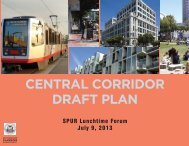energizing innovation in integrated project delivery final report - SPUR
energizing innovation in integrated project delivery final report - SPUR
energizing innovation in integrated project delivery final report - SPUR
You also want an ePaper? Increase the reach of your titles
YUMPU automatically turns print PDFs into web optimized ePapers that Google loves.
to measure the level of <strong><strong>in</strong>novation</strong>; and the practices and processes that encourage and facilitate<br />
<strong><strong>in</strong>novation</strong>. The specific objectives developed for the research study were as follows:<br />
1. Determ<strong>in</strong>e the current extent of <strong><strong>in</strong>novation</strong> with<strong>in</strong> the construction <strong>in</strong>dustry.<br />
2. Identify <strong>in</strong>centives that encourage the generation and implementation of <strong>in</strong>novative ideas.<br />
3. Identify barriers to explor<strong>in</strong>g and implement<strong>in</strong>g new ideas.<br />
4. Identify means for encourag<strong>in</strong>g <strong><strong>in</strong>novation</strong> and overcom<strong>in</strong>g the barriers to <strong><strong>in</strong>novation</strong>.<br />
5. Determ<strong>in</strong>e how <strong><strong>in</strong>novation</strong> can be measured and <strong>in</strong>terpreted us<strong>in</strong>g a variety of metrics.<br />
6. Create practical guidel<strong>in</strong>es for enhanc<strong>in</strong>g <strong><strong>in</strong>novation</strong> on a <strong>project</strong>.<br />
The research was designed to focus on the U.S. construction <strong>in</strong>dustry and <strong>in</strong>corporate <strong>project</strong>s<br />
that have been completed with<strong>in</strong> the last five years. Projects of different sizes and types,<br />
<strong>in</strong>clud<strong>in</strong>g build<strong>in</strong>gs, heavy civil, and <strong>in</strong>dustrial <strong>project</strong>s, were studied to balance the distribution<br />
of <strong>project</strong>s and reflect the breadth of the construction <strong>in</strong>dustry. All aspects of <strong>in</strong>tegrated <strong>project</strong><br />
<strong>delivery</strong>, <strong>in</strong>clud<strong>in</strong>g design, construction, and <strong>project</strong> management, were exam<strong>in</strong>ed. In addition,<br />
an assessment was conducted based on the composition of the <strong>in</strong>tegrated <strong>project</strong> <strong>delivery</strong> team,<br />
i.e., fully <strong>in</strong>tegrated vs. jo<strong>in</strong>t venture. Accord<strong>in</strong>gly, the <strong>in</strong>tended audience of the research<br />
f<strong>in</strong>d<strong>in</strong>gs is the construction community. It is expected that the construction community will<br />
<strong>in</strong>tegrate the f<strong>in</strong>d<strong>in</strong>gs <strong>in</strong>to their <strong>project</strong> development processes through the suggested practices<br />
and guidel<strong>in</strong>es established from the research.<br />
1.3 Research Scope<br />
The research plan for the study was developed based on observations of the <strong>in</strong>teractions among<br />
the key players <strong>in</strong> the construction <strong>in</strong>dustry, previous research experience, the opportunities and<br />
resources available to the researchers, and the challenges and obstacles to conduct<strong>in</strong>g<br />
scientifically-based research on construction <strong>project</strong>s and construction performance. The<br />
foundation for the research plan was the analysis of key <strong>project</strong> data to discover those<br />
environments and practices which most encourage <strong><strong>in</strong>novation</strong>. The research was conducted<br />
us<strong>in</strong>g the survey and case study methods. These methods were selected due to the open nature of<br />
the <strong>in</strong>formation to be gathered, the diversity of the study population (i.e., the construction<br />
<strong>in</strong>dustry), and to ensure reliability of <strong>in</strong>formation gathered. On-l<strong>in</strong>e surveys allow for ga<strong>in</strong><strong>in</strong>g<br />
specific <strong>project</strong> <strong>in</strong>formation from a widely dispersed and diverse sample. The case study method<br />
allows for unstructured <strong>in</strong>terview questions, designed to most fully expose potential <strong>in</strong>novative<br />
techniques and allow the researchers to probe further when needed.<br />
The follow<strong>in</strong>g tasks were the activities planned and undertaken for the research study:<br />
Task 1: Review Current Literature and Identify Metrics (May – July 2006)<br />
Task 1 <strong>in</strong>volved a review of literature on <strong><strong>in</strong>novation</strong> and <strong>in</strong>tegrated <strong>project</strong> <strong>delivery</strong> processes <strong>in</strong><br />
the construction <strong>in</strong>dustry from the follow<strong>in</strong>g sources: academic and professional journals;<br />
<strong>in</strong>dustry periodicals; reliable Internet sources; and related <strong>in</strong>dustry organizations. The results of<br />
the literature review were used to develop a prelim<strong>in</strong>ary list of metrics for measur<strong>in</strong>g <strong><strong>in</strong>novation</strong>.<br />
3




